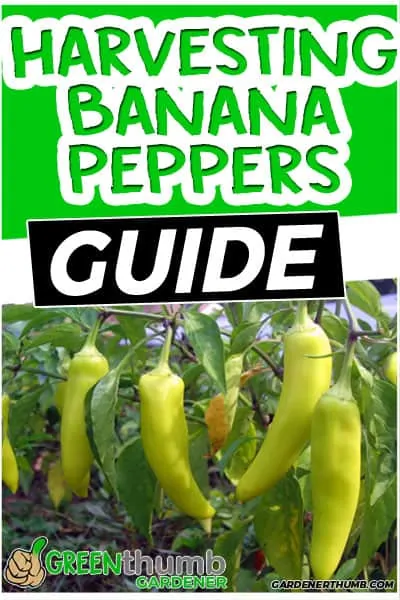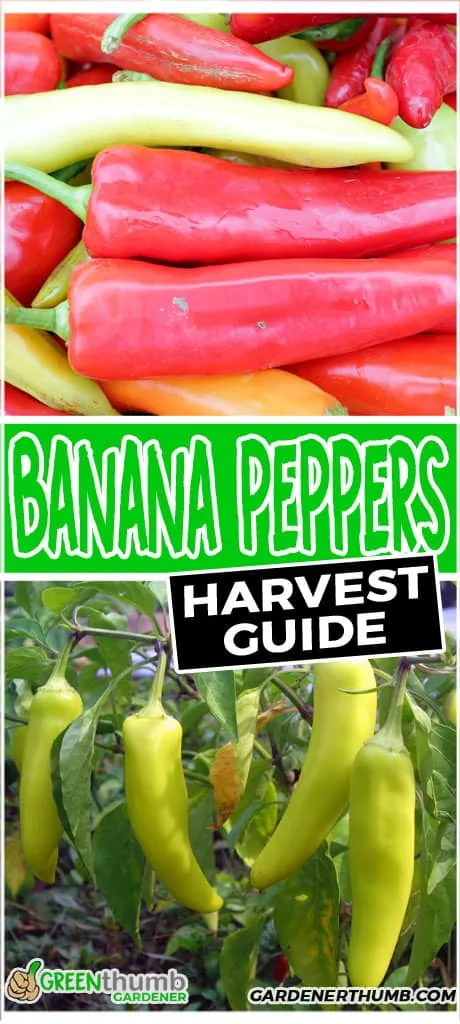When To Pick Banana Peppers | The Ripe Guide
Last updated: 10/31/21
You can pick banana peppers all season long, but if you wait for the right time to pick them, you’ll be rewarded with sweeter, more flavorful peppers. Picking them early in the season before they start flowering is the key to picking a flavorful banana pepper.
We’ve talked before about how you can use this technique to boost the flavor of other vegetables, but this is our favorite time of year to pick banana peppers.
Most gardeners relish in the moment of harvesting their vegetables like tomatoes and banana peppers. It’s equally crucial to know when to pick your banana peppers plant because their flavor depends on it. If you pick them at the wrong time, you lose that unique flavor.
Green thumb Gardener occasionally links to product and/or services offered by vendors to assist you with all your gardening needs. Some of these may be affiliate links, meaning we earn a small commission if items are purchased.
Want to Download a Garden Hack Guide for FREE

Enter your email below and we will send you a guide to help you SAVE money in your garden.
When To Pick Your Banana Peppers
Banana peppers are best when you harvest at the right time, however it’s most likely that you don’t know when to harvest them so you need to keep these tips in mind:
Banana Pepper Tip #1: Ripening Process – Minimize disruptions during growing
On average sweet banana peppers will reach full maturity after about 70 to 75 days after they were first planted.
It’s a mistake to think that all other banana peppers mature at the right time.
Some sweet banana peppers mature at different times for different reasons:
- Banana Pepper Plants may be planted in soils that have different qualities
- Watering my not be consistent to allow plants to grow properly
- Changes in weather patterns may take place and disrupt normal growth

Banana Pepper Tip #2: Flavor – Pick your banana peppers at the right time to get the right flavor
The right time to harvest your hot banana peppers actually impacts their flavor. The tangy and sweetish flavor is not lost when you pick them at the right time. Even the hot banana peppers can vary depending on when you pick them.
Banana peppers seem to be sensitive to the time of picking because when they are picked too early, they tend to lose their unique taste. If you leave them for too long on the tree, they tend to rot and turn into a pulpy mass.
Make certain to pick banana peppers before they are slightly ripe.
Banana Pepper Tip #3 Size and Ripeness: Stay within the sizes and colors
The ideal size of sweet banana peppers that signals they’ve reached maturity varies from 4 to 8 inches.
Lesser sizes mean immaturity while more means too long on the tree with rot and mush as the likely consequence. The colors yellow to a shade of red signals harvesting.
Banana Pepper Tip #4 Color for Picking: A sharp shade of red, signals that you can now pick your banana peppers
The colors green and bright yellow tell you that your banana peppers are immature and not ready for picking or harvest.
Add several more weeks for your banana peppers to dangle on the plant until you see the last shade of color appear – a sharp shade of red. The perfect ripe and mature fruit ready to pick from your gardening efforts.
What to Look For When Picking Banana Peppers
It’s most probable that you would prefer to grow different strains of sweet banana peppers in your garden to satisfy your different tastes.
I would suggest that rather than just haphazardly picking different varieties, I would suggest you look for the two main varieties of banana peppers
Two Main Types
Are you aware that there are two main varieties of banana peppers? Because if not, now is your chance to know it so you can identify and select them:
- Find banana peppers that are of the hot variety and the sweet mild banana peppers.
- Insect resistance varieties are the best to grow
- You should also invest in insect control items to control incursions of pests.

Sweet Mild Banana Peppers
This variety takes less time to mature than the hot variety with a total length of from 4 to 6 inches with a diameter of about half an inch. There are two things to look for when you want to harvest this variety:
- Wait until the sweet banana pepper turns a yellow color and then pick them off to tree OR
- Should you crave a sweeter fruit of the same banana pepper, it is a prerequisite that it must turn red before you remove it from the tree.
Hot Banana Peppers
The hot banana peppers normally grow to a length of six and up to 8 inches and a width a one and a half inches when matured. They normally turn from green to bright yellow and bright red when they are mature.
There are also two things to look for when you want to pick your hot banana peppers:
- Wait until their color turn yellow and you can start harvesting them with their mild sweetish tang OR
- If you crave them really hot, you need to wait until they turn bright red. You need to bear in mind that the yellow ones are best for pickling or immediate use.
You are now familiar with what to look for to pick hot banana peppers which will ensure that your plants and peppers grow properly and supply you with a constant supply of banana peppers
Climatic Impacts on Growth
Now that you know the time it takes your sweet banana peppers to reach maturity you should also know that many factors can affect the growth of your plants and maturity of your banana peppers:
- The water may become too cold for your plant to grow properly
- When drought hits the landscape the growth progress of your plants may slow down.
These factors make it critical that you pick banana pepper varieties wisely before planting.
Some varieties require a shorter period to mature than others while other varieties need more time to reach the mature stage for harvesting.
How to Harvest Your Banana Peppers
The final step in the life of your sweet banana pepper plants is the proper way in harvesting them to earn the fruits of your hard gardening work but to do that, you need to follow these guidelines:
- Most pepper plants are ready to pick when about 6 inches long and a little yellow orange to red color.
- Without damaging the plant or dislodging the young peppers move the plant slightly to expose the dangling banana peppers. You can now discern the maturing progress of your peppers and you can see which are ripe and which are still in their maturing stages.
- With a sharp scissors or shears, cut the pepper from the plant ¼ inch above the pepper on the stem.
- If you have someone to catch the peppers, well and good, but if not just let it drop to the soil. It’s perfectly fine with no harm done to the pepper.
- Make sure you don’t pull the peppers from the bush plant as pulling can cause damage to the plant and also the peppers that are still growing. Cutting ensures that the plant will continue to grow well.
- The vegetable harvesting ends when all the ripe peppers have been cut. Don’t worry because the more you harvest the pepper plant will bloom and more peppers will start the cycle of growth once again.
Storage Tips for Banana Peppers
Banana peppers are the perfect condiment that will last over a long period of time when properly stored after you harvest them when ripe. Most do well at 6 inches long after the full 75 days to almost fully ripen or turn red.
There is no limit to the variety of storage methods for your hot banana pepper plant.
Your best bet would be to store your banana peppers by freezing, pickling or canning.
Refrigeration
- Put newly picked (or bought) hot banana peppers in the refrigerator. Do this even if you plan to store them using a different method later on.
- Place whole sweet banana peppers in a brown bag and put it in the crisper draw
- Put chopped peppers in a resealable plastic bag to keep them fresh.
- Chopped peppers will last for two or three days.

Freezing
- When preparing peppers for freezing, it’s advisable to wear gloves
- Cut off the stems from the peppers and cut the peppers lengthwise
- Get rid of the seeds with your fingers and slice or dice peppers as desired.
- Wash the peppers and place on a cookie sheet and place sheet in a tray
- Place the tray in the freezer and when frozen, slide the contents into freezer bags.
- Label the contents and date for the items.
- The chopped banana peppers can stay good for a year.
Pickling
- Pickling is another way of preserving banana peppers
- Pickled peppers will last for three months.
Canning
- Preserving banana peppers by canning is another way to make them last longer.
- Canned peppers will be edible for up to two years.
Drying
- Wash the banana peppers under cold water
- Remove stems and cut pepper lengthwise
- Use a dehydrator rack to dry peppers. Don’t overlap peppers
- 12 hours should be enough to dry the peppers.
- Use boiled water in a pot to rehydrate your pepper for half an hour
- You can now use your frozen banana peppers.
Final Thoughts
With all the information offered in this article, you are now set to know when to pick your banana peppers and harvest them.
Now you are familiar with the different methods of storing and preserving your banana peppers so you can enjoy their exquisite taste and nutritional qualities during the fall and beyond.








